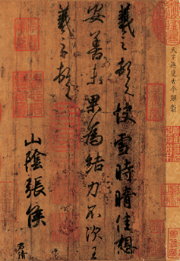临时草稿,测试CSS
Wang Xizhi Calligraphy Work Found In Japan
王羲之书法作品在日本被发现
An extremely rare copy of a work by fourth century Chinese calligraphy legend Wang Xizhi has been unearthed in Japan, the first such discovery in four decades, Tokyo National Museum said Tuesday.
公园四世纪中国著名书法家王羲之的一幅书法作品在日本被发现,东京国立博物馆说,这是40年来首次发现这种作品。
No original works survive, despite their having been treasured by Chinese emperors throughout history for their contribution to the development of the delicate art form.
虽然书法是精妙艺术形式的一个重要组成部分而且中国的历代皇帝们也视这些书法作品为珍宝,但是没有一幅原创的书法作品得以保存下来。
However, Wang′s innovative style was so influential that Chinese courts created precise replicas of his writings more than a millennium ago, some of which are held by Japan as national treasures.
然而,由于王羲之的书法作品是如此的具有创造性,以至于产生了深远的影响,所以中国的皇帝们在1000年前对他的作品进行了大量的复制,而其中的一部分被日本当作国宝保存下来。
“This is a significant discovery for the study of Wang Xizhi′s work,” the museum, which will display it from January 22 to March 3, said in a statement.
“这一个发现对研究王羲之的作品具有重大的意义,”日本国立博物馆在一份声明中说道,在1月22号到3月3号这幅作品将进行展示。
The writing, owned by an individual in Japan whose identity was not disclosed, shows 24 Chinese characters in three lines on a piece of paper roughly 26 centimetres by 10 centimetres (10 inches by 4 inches).
这幅作品被一个日本个人所拥有,这名所有者的姓名还没有被透露出来,这幅作品由24个汉字构成,总共三行,纸张的长为26厘米,宽为10厘米。
It was long thought to be the work of an ancient Japanese nobleman calligrapher, but a recent review by Jun Tomita, Chinese calligraphy expert at the museum, has determined that it was an expertly-made copy of Wang′s writing.
一直以来,人们都以为这幅作品的创作者是一名日本贵族书法家,但是在来自日本国立博物馆的中国书法家Jun Tomita的鉴定后,他认为这幅作品是模仿王羲之的摹本。
The page appears to be part of a letter and includes phrases known to be used by the master calligrapher.
这24个汉字看来好像是一封信的内容的一部分,而且其中包括王羲之经常使用的一些词汇。
“I am tired everyday. I am living only for you,” part of the script says. It also includes the names of his relatives including his son, the museum said.
这幅手迹上写着,“我每天都感到异常的疲倦,没有你我的日子我怎么过,”东京国立博物馆还说,里面还有他亲戚的名字,包括他儿子的名字。
The content of the writing, its style, copying technique, and other factors indicate the copy was made during the Tang Dynasty in the seventh to eighth century by the emperor′s court, the museum said.
博物馆说,从内容、形式、复制技术以及其他的因素综合来看,这幅作品是在公元7-8世纪唐朝的时候由宫廷画师复制而成。
It was likely brought out of China by Japanese commercial or diplomatic missions visiting their powerful continental neighbour during the same era, the museum said.
|
永和九年嵗在癸丑暮春之初㑹
于會稽山隂之蘭亭脩稧事
也羣賢畢至少長咸集此地
有崇山峻領茂林脩竹又有清流激
湍暎帯左右引以為流觴曲水
列坐其次雖無絲竹管弦之
盛一觴一詠亦足以暢敘幽情
是日也天朗氣清恵風和暢仰
觀宇宙之大俯察品類之盛
𠩄以逰目騁懐足以極視聴之
娱信可樂也夫人之相與俯仰
一世㦯取諸懐抱悟言一室之内
㦯囙寄𠩄託放浪形骸之外雖
趣舎萬殊静躁不同當其欣
扵𠩄遇蹔得扵己怏然自足不
知老之将至及其𠩄之既惓情
随事遷感慨係之矣向之𠩄
欣俛仰之閒以為陳迹猶不
䏻不以之興懐况脩短随化终
期扵盡古人云死生亦大矣豈
不痛㦲每攬昔人興感之由
若合一契未甞不臨文嗟悼不
能喻之扵懐固知一死生為虗
誕齊彭殤為妄作後之視今
亦由今之視昔悲夫故列
敘時人録其𠩄述雖世殊事
異𠩄以興懐其致一也後之攬
者亦将有感扵斯文
|



